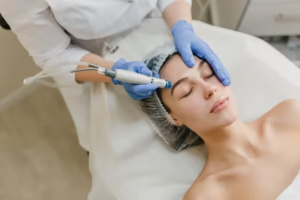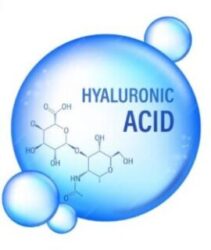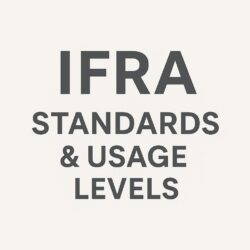Routine for Retinol and Acid Sensitivity
Did you know that nearly 60% of people who start retinol or acid treatments report retinol and acid sensitivity. Side effects like redness, flaking, or burning occur? This is often due to incorrect usage or lack of barrier recovery time. If you’ve ever stopped a retinoid because of irritation, skin cycling might be your breakthrough. This viral yet science-backed routine helps you get results—without compromising your skin barrier or comfort.
What Is Skin Cycling?
Skin cycling is a dermatologist-designed routine that spans four nights, alternating between exfoliants, retinoids, and recovery nights. Dr. Whitney Bowe, a board-certified dermatologist, created this method to balance efficacy with skin barrier health. It’s not about using more—it’s about using smarter and allowing the skin time to repair and respond.

Why It Works for Sensitive Skin
Reduces Over-Exfoliation: Instead of daily acids, exfoliants are limited to 1–2 nights per cycle, lowering your risk of barrier damage and inflammation. Natural AHAs like apple cider vinegar can also offer gentle exfoliation while maintaining the skin’s pH balance, making them a suitable option for sensitive skin routines.
Not sure how acids differ? Here’s a helpful breakdown of AHAs, BHAs, and PHAs explained in detail—so you can choose the right one based on your skin type and goals.
Strengthens Skin Barrier: On recovery nights, you nourish your skin with barrier-repairing ingredients like ceramides, peptides, and fatty acids.
Builds Retinoid Tolerance: Gradual exposure to retinoids helps skin adapt with less irritation. Brands like The Ordinary and Medik8 support phased-introduction protocols for sensitive skin types.
Customizing Skin Cycling for Retinol and Acid Sensitivity
Step 1: Choose the Right Actives
🧴 For Retinol Sensitivity:
Gentle Alternatives: Choose bakuchiol (0.5%), a plant-derived retinol alternative shown in studies to reduce wrinkles without irritation. Another option is retinaldehyde (0.05%), which is one step closer to retinoic acid and generally better tolerated than tretinoin.
To better understand the science behind how retinol works and its benefits, read our full guide on retinol in skincare, including usage tips and side effect management.
Encapsulated Retinol: Products like CeraVe Resurfacing Retinol Serum use encapsulation technology to deliver retinol slowly, significantly reducing irritation and dryness.
🧪 For Acid Sensitivity:
Switch to Lactic Acid: Unlike glycolic acid (which penetrates deeply), lactic acid at 5% with a pH of ~4.5 is gentler and has hydrating properties. It’s ideal for sensitive or dry skin (Healthline, 2024).
For a more plant-derived approach, a botanical AHA blend like Croda’s AHA 1 Phytocomplex offers mild exfoliation from natural fruit sources, suitable for sensitive or reactive skin types.
Use PHAs Instead of AHAs: Gluconolactone, a polyhydroxy acid, exfoliates at the skin’s surface and has antioxidant benefits without the stinging sensation often linked to glycolic or salicylic acids.
Step 2: The 4-Night Cycle
Night 1 – Exfoliation Night
Use a mild chemical exfoliant, such as 5% lactic acid or 2% salicylic acid if you’re acne-prone. Avoid mixing acids with retinoids on the same night, as this can over-exfoliate and damage the barrier.
Night 2 – Retinol Night
Apply a pea-sized amount of encapsulated retinol, ideally after moisturizer to buffer the skin—a method endorsed by dermatologists at the Cleveland Clinic. Always wait at least 20 minutes after cleansing to ensure your skin is completely dry before applying retinol.
Nights 3 & 4 – Recovery Nights
These nights are dedicated to healing and hydration. Use moisturizers rich in ceramides, squalane, and centella asiatica to restore your skin’s lipid barrier. Products like CeraVe Moisturizing Cream and Dr. Jart+ Ceramidin are excellent options. Including hyaluronic acid during recovery nights can deeply hydrate the skin and support barrier repair without causing irritation or clogging pores.

Sample Routine Breakdown
| Step | Exfoliation Night | Retinol Night | Recovery Nights |
|---|---|---|---|
| Cleanser | Gentle foaming cleanser | Cream-based hydrating cleanser | Micellar water or milk cleanser |
| Active | Lactic acid (5%) or BHA | Encapsulated retinol (0.3%) | None |
| Moisturizer | Lightweight gel-based | Barrier-repair cream | Overnight repair mask |
3 Common Mistakes to Avoid
1. Overlapping Actives
Myth: “Layering retinol and vitamin C enhances anti-aging benefits.”
Reality: Combining acidic pH (L-ascorbic acid) with neutral pH retinol may cause instability and reduce effectiveness. Use them at different times—vitamin C in the morning, retinol at night.
2. Skipping Recovery Nights
Many skip the recovery phase, thinking it slows progress. In fact, dermatologists report increased inflammation and chronic redness when recovery time is ignored (Dermstore, 2024).
3. Starting With High Concentrations
Avoid jumping into high-strength actives. Begin with 0.25% retinol or 5% glycolic acid, and increase only after 8 weeks once your skin has adapted, as per clinical guidance from Medik8 and La Roche-Posay.
Best Products for Sensitive Skin
Exfoliants
The Ordinary Lactic Acid 5% + HA: Offers mild exfoliation with a pH of 3.8, ideal for beginners or sensitive skin.
Medik8 Press & Glow PHA Toner: Uses 3% gluconolactone and fermented enzymes to exfoliate gently while maintaining skin moisture.
Retinols
Products like CeraVe Resurfacing Retinol Serum use encapsulated retinol technology combined with niacinamide to reduce post-acne marks while minimizing irritation—ideal for beginners and sensitive skin.
La Roche-Posay Retinol B3 Serum: Includes 0.3% pure retinol with vitamin B3 (niacinamide) to reduce irritation and strengthen the skin.

Recovery Treatments
Dr. Jart+ Ceramidin Cream: Features a 5-ceramide complex, panthenol, and shea butter to support the skin’s lipid matrix.
Kiehl’s Ultra Facial Overnight Hydrating Mask: Formulated with plant-derived squalane and glacial glycoprotein, which hydrates and protects against trans-epidermal water loss.
FAQs: Skin Cycling for Sensitive Skin
Q1: Can I Use Retinol Every Night?
No—start with once per week, and increase to 2–3 nights only if your skin shows no signs of flaking or redness. Gradual adaptation is key (Medik8, 2024 clinical usage guide).
Q2: How Do I Fix Retinol Burn?
Immediately pause all actives for at least 72 hours. Apply 1% hydrocortisone cream (short-term use only) and soothe with colloidal oatmeal creams or thermal spring water mists.
Q3: Can I Use Hyaluronic Acid on Retinol Nights?
Yes! Hyaluronic acid is a non-active humectant that binds water to the skin. Apply it on damp skin before retinol to maintain hydration without irritation.
Key Takeaways
Cycle Frequency: Aim for a 4-night routine—1 exfoliant night, 1 retinol night, and 2 recovery nights—to support balanced, healthy skin.
Buffering Is Key: Always apply retinol over moisturizer if your skin is dry or reactive. This helps reduce transepidermal water loss and stinging.
Patch Test New Products: Before using new actives, test them on your jawline for 48 hours to rule out allergic reactions or delayed sensitivity.



